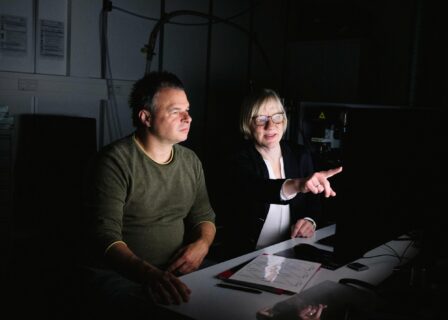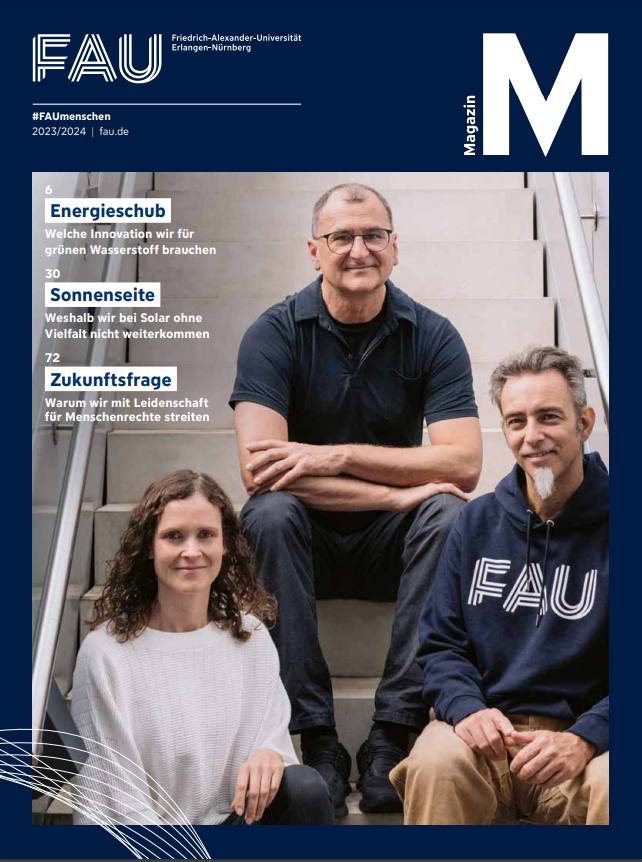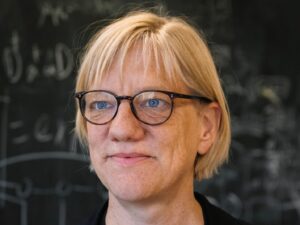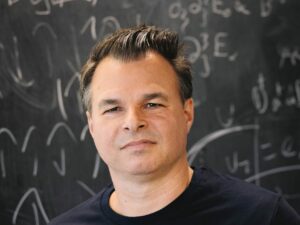Connecting worlds

How conventional electronics and quantum technologies can be combined
Quantum technologies may be on the rise, but conventional electronics are not set to disappear any time yet. Kai Phillip Schmidt and Janina Maultzsch investigate how both worlds can be combined.
It is as big as a boiler and temperatures in its interior are cooled down to ten millikelvin, in other words close to absolute zero. This is what a quantum computer with superconducting processors, qubits, looks like in a research laboratory at the current time. It is hard to imagine that we will have technology like this on our desks anytime soon, let alone in our jacket pocket. “However, we want to start now to explore the physical questions that we have to answer if it is to be possible for our cellphone to be equipped with a quantum chip or a quantum sensor in future,” says Janina Maultzsch.
Maultzsch is Professor of Experimental Physics at the Department of Physics at FAU. Together with a consortium from experimental and theoretical physics, electrical engineering, chemistry, and materials science and engineering, she focuses on one single task: Investigating how quantum technology can be combined with conventional photonics and electronics, not only on the micro, but also on the macro level. “Conventional components have a role to play anyway in the construction of a quantum computer or quantum sensor,” she explains. “A quantum sensor, for example, does not float in the air, it has to be wired, there are contacts and it is embedded in a traditional crystal. We are also interested in how quantum components should be incorporated into existing structures in future. How can we make the most of the interplay between traditional properties and quantum effects and find suitable material platforms?”
Flexible in two dimensions
In her daily research, Janina Maultzsch focuses on small dimensioned solid state structures, whose fascinating properties are determined by the structure of their atomic lattices. Graphene is a prominent example: While multilayer carbon lattices such as graphite are used in pencil leads and as lubricants, single-layer graphene is a transparent and flexible conductor that is used, for example, in flexible touchscreens. Several years ago, a research team at the renowned MIT discovered that two graphene layers become superconducting if they are twisted just one degree apart. If a graphene layer is rolled up, however, the nanotubes formed as a result can be made either semi-conducting or metallic, depending on the angle taken to roll the layer of graphene.
Similarly to graphene, there are a number of materials referred to as two-dimensional materials that demonstrate surprising characteristics as a thin atomic layer. Their functions can be tailored by changing their size, incorporating “foreign” atoms or through interaction with molecules. One particularly exciting aspect involves mathematically defined latices that are created by twisting two layers towards each other. This can create correlations or quantum properties that are non-existent in the individual layer. Janina Maultzsch investigates the interplay between photons, electrons and mechanical oscillations in these structures. “The boundaries between classical physics and quantum physics are fluid in this field of work”, she explains. “That is why I am so interested in what a hybrid world combining quantum and classical physics may look like.”
Quantum computers are like savants
Kai Phillip Schmidt is also fascinated by this question. You could regard the professor of theoretical physics as the sparring partner of Janina Maultzsch. Schmidt investigates how materials behave together and in interaction with light. In particular, he wonders how classical and quantum phases merge into one another and to what extent quantum properties can also survive in macroscopic systems. “The more we know about correlations such as these, the more accurately we will be able to predict and localize quantum phenomena,” he says. That is necessary in order to ensure that only those quantum bits that are involved in a calculation interact with each other. Or in order to enter commands and select results without disturbing the extremely fragile architecture. “Quantum computers are like savants,” says Schmidt. “They deliver outstanding calculations for clearly defined tasks, but react very sensitively to their surroundings.” Schmidt’s contribution to the consortium involves exploring how the computing center of the future will look: Which tasks will quantum computers assume? Will traditional server farms become a thing of the past, or will they move to the periphery? Could quantum technologies and neural networks be integrated on one chip?
Similar questions also arise for other quantum-based applications such as sensor systems and imaging. The initial concepts aim to optically measure the magnetic effect of electron spins using color centers. Color centers are spaces in ion crystals in which one anion is occupied by one or more electrons. “That promises a pioneering insight into the fascinating behavior of complex materials,” explains Kai Phillip Schmidt. “This is interesting, for example, to help us gain a basic understanding of superconductors.” Research is necessary to discover which microelectronic infrastructure is suitable for embedding quantum sensors and how it could be improved using conventional components.
Surfing ahead of the wave
Joining quantum mechanical and conventional processes of light, matter and spin in new architectures: That is the major objective of Maultzsch and Schmidt. They are looking for a way to combine the advantages of the technologies at the same time as eliminating their disadvantages. Conventional electronics are diverse and robust, but they are reaching their limits when it comes to miniaturization, and they also have a high energy consumption. The newly developed quantum technologies promise exponential growth in performance for special tasks, but are sensitive to external disruptions. And neural networks are highly energy efficient, but are not suited to certain calculation tasks.
At the current time, research and development of quantum technologies is characterized by a wave of euphoria, and rightly so. Janina Maultzsch and Kai Phillip Schmidt are trying to surf ahead of this wave and connect things that tend to have been regarded separately until now. They are conducting research into combining two worlds that we will view as one as a matter of course just a few decades from now.
by Matthias Münch
Profilzentrum Licht.Materie.Quantentechnologien
Die wissenschaftliche und technologische Entwicklung unserer Gesellschaft ist ohne Photonik und Elektronik nicht vorstellbar, welche das Rückgrat unserer heutigen Informationstechnologie bilden. In den letzten Jahren hat sich der Fokus an der FAU auf die gemeinsame Betrachtung von Licht und Materie gerichtet, was viele neue Phänomene und Technologien verständlich machen wird und damit die Grundlage für Schlüsseltechnologien des 21. Jahrhunderts bildet. Dies erfordert substanzielle Anstrengungen in der Grundlagen- wie in der angewandten Forschung, die im Profilzentrum Licht.Materie.Quantentechnologien der FAU gebündelt werden.
This article is part of the FAU Magazin
 A university thrives because of the people who research, study, teach and work there. A university is supported by people who are connected to it as alumni, friends and sponsors and who are committed to promoting its interests all over the world.
A university thrives because of the people who research, study, teach and work there. A university is supported by people who are connected to it as alumni, friends and sponsors and who are committed to promoting its interests all over the world.
They all contribute their unique talents, skills and perspectives. It is this diversity that makes our FAU a place of innovation, a place where many talented individuals tackle the major challenges of our times together, and a place where they keep finding answers.
Read more articles online Download: FAU Magazin (PDF)

